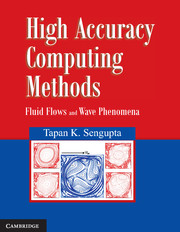Book contents
- Frontmatter
- Contents
- Foreward
- Preface
- Chapter 1 Basic Ideas of Scientific Computing
- Chapter 2 Governing Equations in Fluid Mechanics
- Chapter 3 Classification of Quasi-Linear Partial Differential Equations
- Chapter 4 Waves and Space–Time Dependence in Computing
- Chapter 5 Spatial and Temporal Discretizations of Partial Differential Equations
- Chapter 6 Solution Methods for Parabolic Partial Differential Equations
- Chapter 7 Solution Methods for Elliptic Partial Differential Equations
- Chapter 8 Solution of Hyperbolic PDEs: Signal and Error Propagation
- Chapter 9 Curvilinear Coordinate and Grid Generation
- Chapter 10 Spectral Analysis of Numerical Schemes and Aliasing Error
- Chapter 11 Higher Accuracy Methods
- Chapter 12 Introduction to Finite Volume and Finite Element Methods
- Chapter 13 Solution of Navier–Stokes Equation
- Chapter 14 Recent Developments in Discrete Finite Difference Computing
- Exercises
- References
- Index
Chapter 13 - Solution of Navier–Stokes Equation
Published online by Cambridge University Press: 05 January 2014
- Frontmatter
- Contents
- Foreward
- Preface
- Chapter 1 Basic Ideas of Scientific Computing
- Chapter 2 Governing Equations in Fluid Mechanics
- Chapter 3 Classification of Quasi-Linear Partial Differential Equations
- Chapter 4 Waves and Space–Time Dependence in Computing
- Chapter 5 Spatial and Temporal Discretizations of Partial Differential Equations
- Chapter 6 Solution Methods for Parabolic Partial Differential Equations
- Chapter 7 Solution Methods for Elliptic Partial Differential Equations
- Chapter 8 Solution of Hyperbolic PDEs: Signal and Error Propagation
- Chapter 9 Curvilinear Coordinate and Grid Generation
- Chapter 10 Spectral Analysis of Numerical Schemes and Aliasing Error
- Chapter 11 Higher Accuracy Methods
- Chapter 12 Introduction to Finite Volume and Finite Element Methods
- Chapter 13 Solution of Navier–Stokes Equation
- Chapter 14 Recent Developments in Discrete Finite Difference Computing
- Exercises
- References
- Index
Summary
Introduction
Having established the tools for discretization and methods of analysis of the discretized equation, here we explain methods for solving Navier–Stokes equations of steady and unsteady incompressible viscous flows. Versions of Navier–Stokes equation in primitive and derived variables, expressed in inertial and non-inertial frames have been given in Chapter 2. Various versions of pressure Poisson equation are also derived in Chapter 2, which is to be solved for accurate evaluation of loads and detailed pressure distribution.
Navier–Stokes equation is an evolution equation for vorticity, a primary physical quantity of interest for unsteady laminar and turbulent flows. Primarily, vorticity is generated at physical boundaries for wall-bounded flows, as a consequence of no-slip condition. In free shear layers, vorticity is generated by flow instabilities at interfaces in mixing layers and jets; primary instability mechanisms are attributed to Rayleigh–Taylor, Kelvin–Helmholtz, Görtler mechanisms. Hence, VTE is central for analysis and solution of Navier–Stokes equation. Attendant velocity field can be obtained from the solution of SFE for 2D flows. Poisson equations relating velocity and vorticity field can also be solved for 2D and 3D flows in vorticity–velocity formulation. As stated in Chapter 2, vorticity–stream function formulation is preferred over vorticity–velocity formulation, whenever accurate solution is desired.
- Type
- Chapter
- Information
- High Accuracy Computing MethodsFluid Flows and Wave Phenomena, pp. 405 - 441Publisher: Cambridge University PressPrint publication year: 2013



